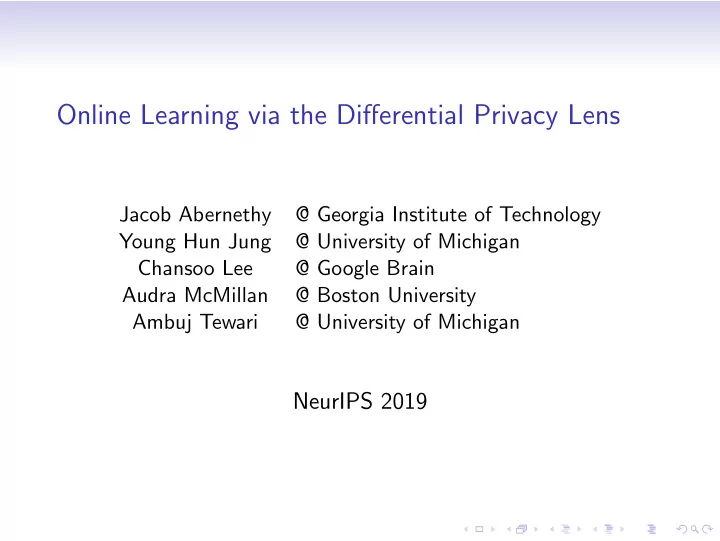

Online Learning via the Differential Privacy Lens Jacob Abernethy @ Georgia Institute of Technology Young Hun Jung @ University of Michigan Chansoo Lee @ Google Brain Audra McMillan @ Boston University Ambuj Tewari @ University of Michigan NeurIPS 2019
Online Learning via the Differential Privacy Lens DP inspired stability is well-suited to analyzing OL algorithms
Adversarial Online Learning Problems • A sequential game between Learner and Adversary • Learner chooses its action x t ∈ X , which can be random • Adversary chooses a loss function ℓ t ∈ Y (NOT random) • Full Info. : the entire function ℓ t is revealed to the learner • Partial Info. : only the function value ℓ t ( y t ) is revealed
Adversarial Online Learning Problems • The learner’s goal is to minimize the expected regret : T T � � ℓ t ( x t )] − L ⋆ T , where L ⋆ E [Regret T ] = E [ T = min ℓ t ( x ) . x ∈X t =1 t =1 • Zero-order bound proves E [Regret T ] = o ( T ) • First-order bound proves E [Regret T ] = o ( L ⋆ T ) • The first-order bound is more desirable if L ⋆ T = o ( T ) • OCO, OLO, expert problems, MABs, bandits with experts
Differential Privacy Let A be a randomized algorithm that maps a data set S to a decision rule in X • A ( S ) will be available to users but NOT S itself • We do NOT want the users to infer our data set S from A ( S ) • Suppose S and S ′ differ only by a single entry ⇒ We want A ( S ) and A ( S ′ ) to be similar
Differential Privacy • The δ -approximate max-divergence between two distributions P and Q is (sup takes over all measurable sets) log P ( B ) − δ D δ ∞ ( P , Q ) = sup Q ( B ) P ( B ) >δ • We say A is ( ǫ, δ )-DP if D δ ∞ ( A ( S ) , A ( S ′ )) < ǫ
New Stability Notions Main Observation In online learning, Follow-The-Leader algorithm performs badly while F-T-Purturbed-L or F-T-Regularized-L do well. Definition 1 (One-step differential stability) For a divergence D , A is called DiffStable( D ) at level ǫ iff for any t and any ℓ 1: t ∈ Y t , we have D ( A ( ℓ 1: t − 1 ) , A ( ℓ 1: t )) ≤ ǫ Definition 2 (DiffStable, when losses are vectors) For a norm || · || , A is called DiffStable( D , || · || ) at level ǫ iff for any t and any ℓ 1: t ∈ Y t , we have D ( A ( ℓ 1: t − 1 ) , A ( ℓ 1: t )) ≤ ǫ || ℓ t || Remark. ℓ 1: t − 1 and ℓ 1: t only differ by one item!
Key Lemma Suppose loss functions always belong to [0 , B ] for some B and A is DiffStable( D δ ∞ ) at level ǫ ≤ 1. Then the regret of A satisfies T + 3 E [Regret( A + ) T ] + δ BT . E [Regret( A ) T ] ≤ 2 ǫ L ∗ • We can adopt DiffStable algorithms from DP community • E [Regret( A + ) T ] is usually small (independent of T ) • δ can be set to be as small as 1 / BT
Online Convex Optimization Algorithm 1 Online convex optimization using Obj-Pert 1: Given Obj-Pert solves the convex optimization while preserving DP 2: for t = 1 , · · · , T do Play x t = Obj-Pert( ℓ 1: t − 1 ; ǫ, δ, β, γ ) 3: 4: end for • Algorithm 1 is automatically DiffStable due to Obj-Pert (object perturbation) algorithm from DP literature • When applying the Key Lemma, E [Regret( A + ) T ] scales as 1 ǫ E [Regret( A ) T ] ≤ 2 ǫ L ∗ T + 3 E [Regret( A + ) T ] + δ BT • Tuning ǫ and setting δ = 1 / BT , we get the first-order regret bound of O ( � L ⋆ T )
Other Applications • OLO/OCO, Expert Learning, MABs, Bandits with Experts • Zero-order and First-order regret bounds • Provide a unifying framework to analyze OL algorithms • Come to Poster #53 @ East Exhibition Hall B + C (that starts NOW!) for more details Thanks!
Recommend
More recommend